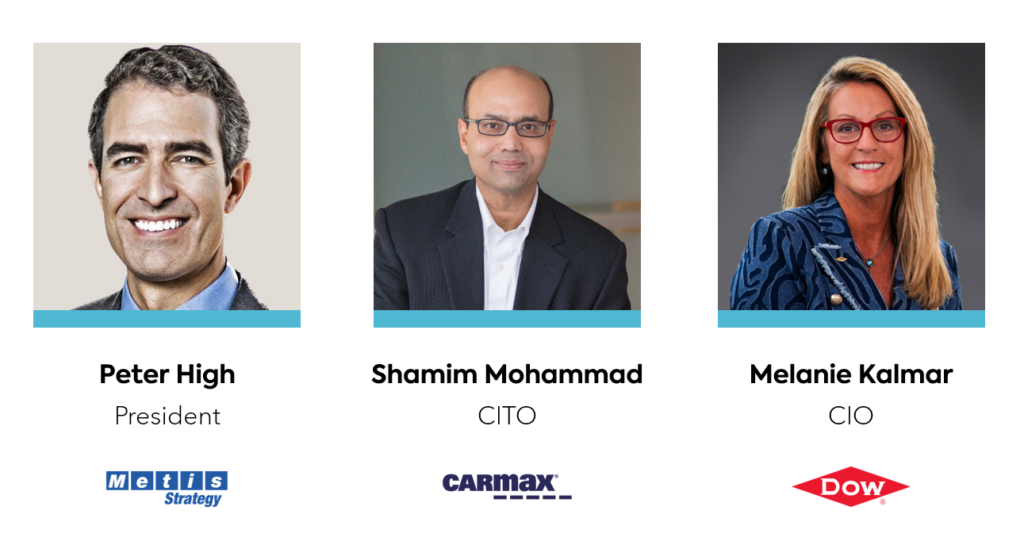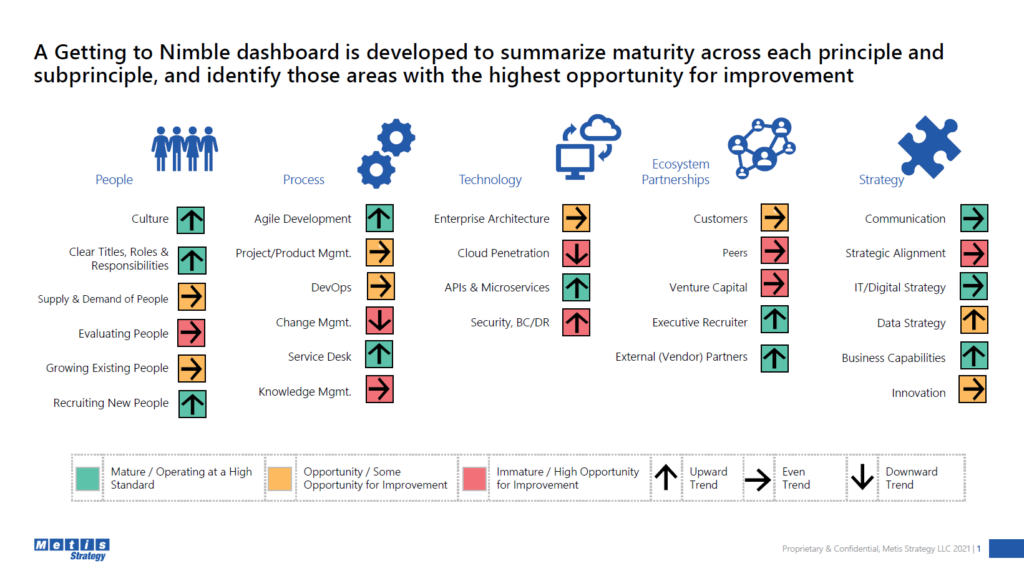

Organizations are just beginning to grapple with the dramatic changes brought about by 20 months of pandemic. The “Great Resignation” is more tangible than ever. A June 2021 survey by Qualtrics shows that 44 percent of all workers — and more than half of all executives — plan to look for a new job next year.
The challenges are especially acute for so-called ‘Digital Immigrants’ — companies born before the digital age — that are now undergoing a period of rapid transformation. Established organizations looking to move at the speed of change are seeking solutions for how to recruit and retain talent, compensate people fairly, and modernize their processes.
To help them become more nimble, our panel of top-tier CIOs was joined by Peter A. High, president of Metis Strategy and author of Getting to Nimble: How to transform your company into a digital leader, along with CarMax CITO Shamim Mohammad and Dow CIO Melanie Kalmar.

Key Takeaways:
The Path to Nimble
Getting to nimble means addressing change across five areas of focus common to all organizations: People, process, technology, partnerships, and strategy. Digital immigrants need to evaluate how mature they are across 27 subcategories, as well as whether they are headed in the right direction for each.

The purpose of this approach is to understand how an organization is doing, to eliminate blind spots, and identify the areas that need the most focus. Executives must also stay mindful of categories that could be neglected, and create a plan to ensure those areas also reach maturity.
Getting to nimble means putting the organization in a position to seize opportunities as they present themselves and stave off serious issues before they become crises. A great example of a company that excels at this is Mars Candy. When traditional Halloween festivities in 2020 were canceled due to the pandemic, it could have been a disaster for the company. Instead, Chief Digital Officer Sandeep Dadlani turned it into an opportunity.
Mars created Treat Town, a digital Halloween experience where trick or treaters knocked on virtual doors and received credits redeemable for real candy. While it was no substitute for live trick or treating, Treat Town produced unforeseen benefits. Kids could now experience Halloween with family members and friends in different parts of the country. Unique communities began to form around the holiday.

The Treat Town app was downloaded 500K times and generated 1.5x as many impressions as a Super Bowl ad. It was so successful that Mars opened Treat Town again this year, and is considering implementing similar experiences for Valentines and Mother’s Day.
This didn’t happen by accident. Mars has a remarkable digital engine that allows it to develop fully functional ideas like Treat Town much faster. That engine has been deployed in more than 500 sprints and 75 use cases. When an unforeseeable event like the pandemic happened, Mars was ready for it. That’s the essence of being nimble.
Go Beyond the Four Walls
When Shamim Mohammad first joined CarMax as CIO, he partnered with the company’s CMO and COO to persuade the rest of the executive team to go on a digital safari to Silicon Valley. Three days of meetings with digital native companies, both large and small, convinced the team that it needed stronger CRM capabilities — and it needed them now. Seeing how other companies operated created a sense of urgency that might not have otherwise taken hold. Five years later, CarMax has nearly 60 product teams working on new initiatives.
“We had great technology to begin with, but we’d fallen a little behind. When you’re the market leader, complacency can set in. I wanted the leadership team to see how far behind we’d gotten and some of the opportunities we’d missed.” — Shamim Mohammad
Today, CarMax CEO Bill Nash and his senior leadership team visit one of the company’s 230+ locations frequently to serve meals to employees and listen to their concerns in an open town hall format. The company’s inclusive culture is a key reason why Fortune has named CarMax one of the top 100 places to work for 17 consecutive years.
Reward Your Tech Stars
Great engineers don’t necessarily make great managers. Yet in many corporations, the path toward higher levels of compensation requires giving people direct reports. This outmoded way of thinking needs to change. Organizations that want to hold onto tech talent need to carve out alternate career tracks for their most mission-critical employees.
“One thing we all have to do is work with HR to redesign compensation for tech. We need to get comfortable with the idea that some senior engineers are going to make more money than their leaders. We can’t just focus on the new talent we need to hire — our existing talent needs some TLC as well.” — Melanie Kalmar
A few years ago Dow instituted a new technical career ladder that allows engineers to advance to senior levels without people reporting to them. This allows people with excellent tech skills who are not always the best leaders or mentors to qualify for bonuses and long-term incentives.
Nurture Young Talent and Give it Fast Elevators
Recruiting in today’s environment is an ongoing challenge that shows no sign of abating. Well-designed internship programs that give students meaningful work are a great way to attract and evaluate new talent. People who are hired out of these programs typically get faster elevators up through the organization.
For example, Capital One has interns do rotations through different parts of the company, before they eventually land in one area. This immerses them in company culture, so that when they return to school, they become advocates for the bank.
Because computer science graduates are in such short supply, and not every tech job necessarily requires a four-year degree, apprenticeships and internal training programs like Capital One University are ways to develop talent and build skills for the future.
Make Change a Core Competency
Peter points out that Google routinely polls employees to identify which processes are preventing the company from being more nimble. These ‘bureaucracy buster’ days foster a collective radar where everyone is continually looking for more efficient ways to work. Just like technology that was state of the art when implemented 10 years ago, business practices and even cultures need to be re-examined and retired to make room for the new.
